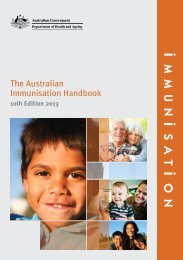3.30 MB - Academy of Medicine of Malaysia
3.30 MB - Academy of Medicine of Malaysia
3.30 MB - Academy of Medicine of Malaysia
Create successful ePaper yourself
Turn your PDF publications into a flip-book with our unique Google optimized e-Paper software.
MANAGEMENT OF HIV INFECTION IN CHILDREN<br />
d) Barriers to ART Adherence<br />
Barriers to adherence among adolescents include those related to development<br />
such as denial, mistrust, rebellion, concrete thinking and other issues such<br />
as fear <strong>of</strong> disclosure, poor understanding, chaotic lifestyle, substance abuse<br />
and lack <strong>of</strong> family support. Low self- esteem, depression and feelings <strong>of</strong><br />
hopelessness are other common factors.<br />
Efforts need to be focused on reinforcing adherence as described above<br />
and include pillboxes, timers, reminder systems, peer-to-peer adherence<br />
counselling. A lower pill burden, (e.g. co- formulated fixed dose combinations<br />
and drugs with daily dosing (e.g. Ten<strong>of</strong>ovir) and regimens with minimal<br />
adverse effects all facilitate adherence.<br />
e)Transition to Adult Care<br />
Transition is facilitated if adult clinics are in the same facility, and where one<br />
or more providers work in both settings with similar multidisciplinary support.<br />
3.2.5 Treatment failure<br />
Most children can remain stable on HAART for many years. However, at<br />
some point, assessment <strong>of</strong> the regimen will become necessary. It must be<br />
noted however that the patient’s best response will be to his/her first-line<br />
HAART regimen.<br />
Treatment failure is defined as suboptimal response or a lack <strong>of</strong> sustained<br />
response to therapy. It can be defined as an inadequate virologic, immunologic,<br />
or clinical response to antiretroviral therapy. It usually begins with virological<br />
213, Level 9<br />
failure, followed by immunological failure and eventually clinical failure.<br />
Careful assessment is required to evaluate the aetiology <strong>of</strong> treatment failure<br />
and determine the appropriate management strategy. A change in ART may be<br />
considered in a number <strong>of</strong> different situations, including:<br />
• Suboptimal virologic response to therapy or a sustained increase in viral<br />
load<br />
• Suboptimal immune response to therapy or immunologic deterioration<br />
• Suboptimal clinical response to therapy or clinical disease progression<br />
• Significant drug intolerance or toxicity<br />
• Significant and unmodifiable adherence issues.<br />
39

















